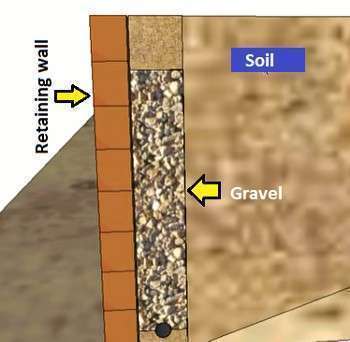A retaining wall is a structure which resists active and passive earth pressure beside the road or compound. The retaining wall should be strong enough to bear backfill load as well as vibration due to moving objects beside it.
What is backfill in retaining wall?
Backfill is the geological materials used to fill the gap beside the retaining wall. After de-shuttering of retaining wall, we have to fill the remaining excavated area with the help of sand, soil, or gravel. These materials are known as backfill in retaining walls.

After the construction of the retaining wall, we have to backfill the retaining wall with soil, gravel, sand, clay etc. The best backfill material for retaining walls is gravel. Gravel do not capture the pore water or water between their void. So, extra load from the backfill to the retaining wall is reduced, unlike soil filling.
Generally, for best practice, we should provide gravel from the bottom of the retaining wall up to a minimum of one-third of the wall, after that we have to provide soil as binding materials above the gravel. The grave under the soil acts as drainage in both directions of the retaining wall ie, laterally and vertically.
How to backfill a retaining wall?

Here we will discuss step by step procedures to backfill a retaining wall.
1) First of all, we should provide a drainage pipe at the base of the retaining wall if possible.
2) After that we should provide concrete to bear the load above the drainage pipe.
3) After that well-graded gravel above the drainage pipe should be filled followed by compaction.
4) The weep hole should be provided perpendicular to the face of the retaining wall to take out water from the backside of the wall.
5) Gravel should be provided up to 3/4th of the height of the retaining wall.
6) At last the soil should be poured followed by compaction above the gravel.
In this way, we can backfill a retaining wall effectively and sustainably.
how to calculate backfill for a retaining wall?
You can use this tool below to calculate the backfill and excavation of the soil.
Volume of Soil in Excavation Calculator | Cutting and Filling
Further, we can calculate the backfill for a retaining wall by calculating the volume of the excavated area.
The volume of backfill depends upon the nature of the land. ie, rectangular, circular, or square in shape.
The volume of different shapes of the backfill can be calculated as,
Volume = Base Area x Height of backfill
The base area may be rectangular, circular, or square in shape.
Happy Learning – Civil Concept
Read Also,
What is the thickness required of a masonry wall?